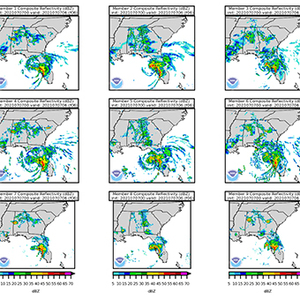GSL has prototyped the Rapid Refresh Forecast System on the Cloud

A team of CIRES Software Engineers at NOAA GSL has prototyped the Rapid Refresh Forecast System on the Cloud. This work was in close collaboration with NOAA Environmental Modeling Center (EMC) on a FY19 Disaster Supplemental project. The first configuration tested was a forecast ensemble capability in real time as a part of NOAA's Hazardous Weather Testbed
Spring Forecast Experiment.
There are many advantages -- scientific and otherwise -- to this prototyping effort extending far beyond the primary goal of running additional scientific experiments to speed development efforts for the upcoming operational implementation of the Short Range Weather App under the Unified Forecast System umbrella. The cloud provides additional, scalable resources to use now since the current fleet of NOAA high performance computing platforms are already near capacity. This is among the first projects to scope both cost and computation resources needed for these types of configurations. Porting the App to the cloud, and sharing that capability with the community, opens up cloud computing as a new viable extension beyond conventional HPC hardware leading to greater R2O velocity. Providing datasets from the Testbeds on a free and open platform gives the UFS Community power to assess and analyze the performance of the system.
These secondary benefits will help carry us into the future of not only leveraging the latest in cloud technology, but into the world of a truly community-based Unified Forecast System.
In addition, the GSL Team modified the Unified Forecast System (UFS) Short Range Weather (SRW) Application to support the configuration of a forecast ensemble that allows each member to use input from different models as initial and boundary conditions. They set physics options independently for each member, and added a new physics suite option before it was widely available in the SRW App. In addition, the App was ported from NOAA’s Research and Development High Performance Computing System platforms to an Amazon Web Services (AWS) Cloud Parallel Cluster architecture designed by our EMC colleagues with help from AWS, General Dynamics Information Technology (GDIT), and Parallel Works Staff. The thoughtful architecture planning prioritized available resources across availability zones, allowing for reliable, on-time delivery of the products. This collaborative effort to prototype the RRFS Forecast Ensemble involved participation in the NOAA Hazardous Weather Testbed Spring Forecast Experiment, and delivered near-real time guidance to participants via a NOAA Big Data Program AWS Bucket.
